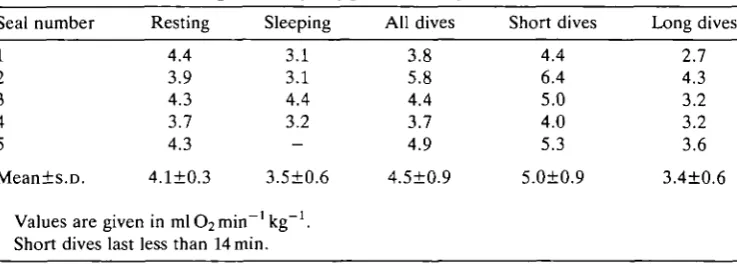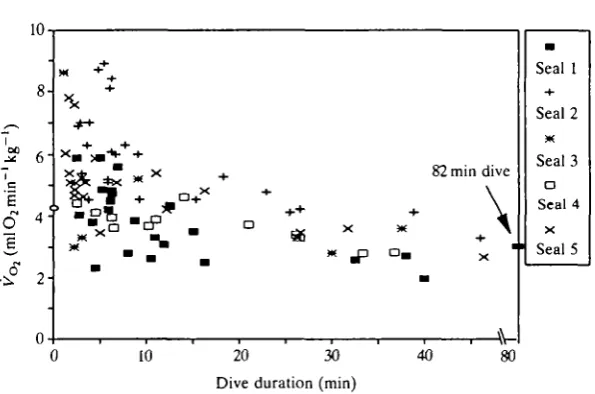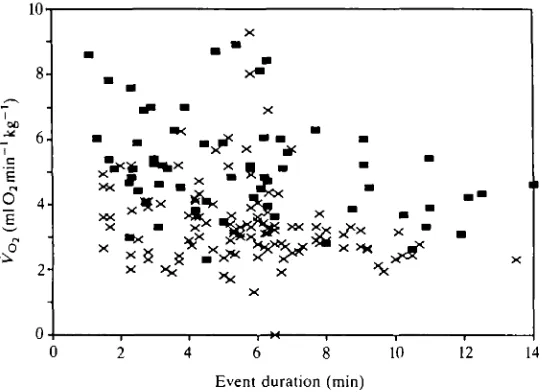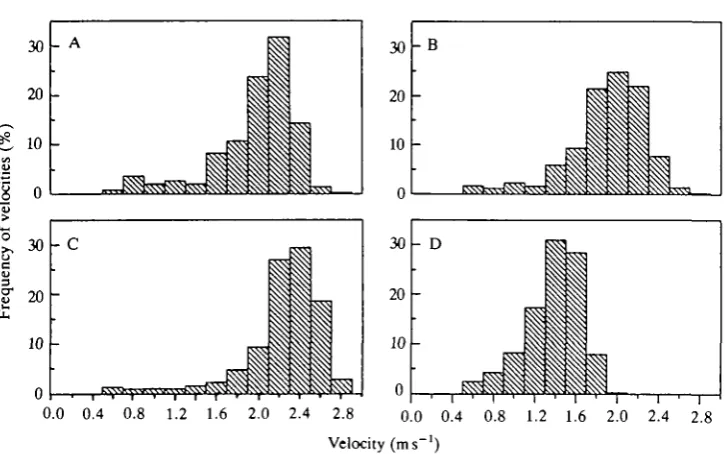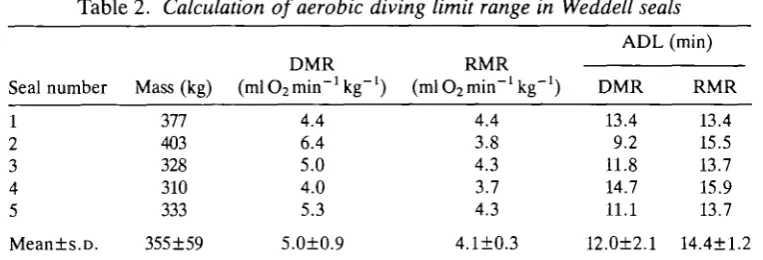METABOLIC RATES OF FREELY DIVING WEDDELL SEALS:
CORRELATIONS WITH OXYGEN STORES, SWIM VELOCITY
AND DIVING DURATION
BY MICHAEL A. CASTELLINI*, GERALD L. KOOYMAN
AND PAUL J. PONGANISScripps Institution of Oceanography, Scholander Hall, University of California San Diego, La Jolla, CA 92093, USA
Accepted 30 December 1991
Summary
The metabolic rates of freely diving Weddell seals were measured using modern methods of on-line computer analysis coupled to oxygen consumption instrumen-tation. Oxygen consumption values were collected during sleep, resting periods while awake and during diving periods with the seals breathing at the surface of the water in an experimental sea-ice hole in Antarctica. Oxygen consumption during diving was not elevated over resting values but was statistically about 1.5 times greater than sleeping values. The metabolic rate of diving declined with increasing dive duration, but there was no significant difference between resting rates and rates in dives lasting up to 82min. Swimming speed, measured with a microprocessor velocity recorder, was constant in each animal. Calculations of the aerobic dive limit of these seals were made from the oxygen consumption values and demonstrated that most dives were within this theoretical limit. The results indicate that the cost of diving is remarkably low in Weddell seals relative to other diving mammals and birds.
Introduction
To construct reasonable models of the metabolism and the physiological constraints on the behavior of freely diving marine mammals, estimates of accessible body oxygen stores are divided by estimates of diving metabolic rate; the resulting time is denned as the approximate aerobic diving limit (ADL) and the results compared with dive duration/lactate appearance curves (Kooyman et al. 1980, 1983). The calculation of body oxygen stores available for diving involves summing the oxygen capacity of various tissues and estimating the level of oxygen extraction from these stores during the dive. While body oxygen stores are relatively straightforward estimates, determining to what level the oxygen stores
* Present address for correspondence and for reprint requests: Institute of Marine Science, University of Alaska, Fairbanks, AK 99775, USA.
are utilized during diving is complex and has only been achieved under artificial conditions of forced submersion in elephant seals (Eisner, 1969). It is even more difficult to estimate the metabolic rate in a freely diving seal and this value is usually extrapolated from exercise studies under non-field conditions or is taken from general relationships of mass vs metabolic rate.
Only one previous study has measured the oxygen consumption rates of seals diving under natural conditions. Kooyman etal. (1973) published oxygen con-sumption (VO2) values for freely diving Weddell seals (Leptonychotes weddellii) in
Antarctica. They built a large respirometry system over a hole in the sea-ice into which the seals could breathe after returning from dives. They concluded that diving VOl was only about twice that at rest, much lower than the foraging
metabolic rates estimated using different methods for fur seals and sea lions (Costa etal. 1989; Ponganis etal. 1990; Costa, 1991). However, because of the cumber-some methods used by Kooyman etal. (1973), the system could not be used to monitor the seals continuously over long periods or during periods of rapid change. Therefore, the range of behavior studied was limited.
The purpose of this project was to utilize modern methods of on-line computer-based monitoring to collect values of Vo^ continuously from Weddell seals during a
range of activities and over long periods in order to test and to expand the earlier findings of Kooyman et al. (1973). Using the same basic animal handling methods of the earlier study, patterns of oxygen consumption were monitored during recovery periods from long and short dives, during bouts of sleep-associated apnea and during awake, rest periods.
Materials and methods
Animal handling
Procedures for working with Weddell seals under free-diving conditions have been well documented and this study followed those general techniques (Kooy-man, 1968; Kooyman etal. 1973). Five adult Weddell seals (average mass=355±59kg; 3 females, 2 males) were captured on the sea-ice near McMurdo Station, Antarctica. The animals were weighed on a strain gauge cattle platform, accurate to ±1 kg, and then allowed to enter the sea water through a hole cut in the ice under a small portable heated laboratory.
Because the seals were confined to the study site, which was located several kilometers from any other breathing hole, they always came back to the 'laboratory'. There were no other restrictions on the seals' behavior and, over several days, they routinely made many short dives, some long dives, exhibited long bouts of sleep apnea, rested quietly and, in some cases, reamed at the hole to build an exit.
Oxygen consumption
computer-analyzed open-circuit oxygen consumption rates of seals in water (Davis etal. 1985; Fedak, 1986). Basically, once the animal was in the water, a large acrylic dome was placed over the hole and sealed against the water surface. Room air was moved through the dome at a rate of about 6001 min"1 using a vacuum motor. Exact flow rates for each experiment were determined by passing a known flow of 100 % nitrogen into the dome intake and measuring the change in oxygen content of the outflow air. A subsample of the outflow air was continuously drawn through water vapor and carbon dioxide extraction columns and then analyzed for oxygen content with an Ametek S3-A oxygen analyzer. The analog output of the oxygen analyzer was sent to a digital converter and then to an Apple computer. A BASIC program, modified from Davis etal. (1985) to provide more rapid sampling, collected the data and calculated the percentage of oxygen in the expired air and the oxygen consumption of the seal every 10 s. These data were reduced and analyzed using QUATTRO (Borland) and STATISTIX (Analytical Software) computer packages.
Event recording
Resting oxygen consumption values were summed and averaged for seals that were quiet, awake and breathing regularly. For both dive and sleep apnea 'events', the oxygen consumption was summed for the time that the seal was breathing until the next event. During bouts of these activities, the recovery breathing period is short (less than 5 min; Castellini et al. 1988) and easily defined as the time until the next dive or breath-hold. For isolated dives interspersed with long periods at the surface, recovery was defined as the time at which oxygen consumption returned to resting values or when a period of sleep apnea began. The total amount of oxygen consumed during the recovery period was divided by the time of breath-holding plus the time of recovery. For example, for a 15 min dive with a 4min recovery, the oxygen used during the 4 min at the surface was divided by the total dive plus recovery time of 19 min to arrive at an oxygen consumption rate for the entire event. This oxygen consumption value was then plotted against the time of the breath-hold in order to relate oxygen consumption rates to dive or sleep apnea time.
Swimming velocity
Results
Dive and sleep apnea profiles
During this study, 87 dives and 119 sleep apnea events were recorded for the five seals. Fig. 1 shows the frequency of dive and apnea events as a function of apnea time. Most dives (77%) lasted less than 20min with a modal diving time of 4.5min and a maximum diving time of 82 min. All sleep-associated apnea events lasted less than 14 min (max=13.5min) and had a modal time of 6 min.
Resting metabolic rate
The resting rate of oxygen consumption (RMR) for five seals was 4.1±0.3ml C^min"1 kg"1 ( ± S . D . ; Table 1) over a total recorded time of 8.8 h. In one seal that reamed at the ice hole, the metabolic rate was 5.6mlO2min-1kg-1.
[image:4.451.85.367.244.440.2]• 6 8 10 12 14 16 18 20 22 24 26 28 30>30 Breath-hold duration (min)
Fig. 1. Histogram of frequency of diving and sleep apnea duration for five Weddell seals. The plot separates events of less than 30 min into 2-min blocks and sums all events over 30 min duration into a single bar.
Table 1. Average rates of oxygen consumption in Weddell seals
Seal number
1 2 3 4 5
Mean±s.D.
Values are Short dives
Resting
4.4 3.9 4.3 3.7 4.3
4.1±0.3
given in mlC^min"1 last less than 14 min
Sleeping
3.1 3.1 4.4 3.2
-3.5±0.6
kg"1
-All dives
3.8 5.8 4.4 3.7 4.9
4.5±0.9
Short dives
4.4 6.4 5.0 4.0 5.3
5.0+0.9
Long dives
2.7 4.3 3.2 3.2 3.6
[image:4.451.43.412.515.647.2]E O
\J-
8-6"
4 -
2-
0-X
•
4-fe< X * +
• - X JD
82 min dive
X A
°m x ' •
,
r—\\-• Seal 1
Seal 2
X
Seal 3
D
Seal 4
X
Seal 5
10 20 30 Dive duration (min)
[image:5.451.80.378.66.263.2]40
Fig. 2. Rate of oxygen consumption for all dive events for five Weddell seals versus diving duration. The longest diving duration recorded (82 min) is noted on the right-hand axis while the average resting value of oxygen consumption (4.1ml
1
kg"1) is marked on the left-hand axis.
Metabolic rate for diving events
The metabolic rates for all dive 'events' (diving time plus recovery time) are averaged for each seal in Table 1. The individual rates of oxygen uptake for all 87 dives are plotted against diving time in Fig. 2. The average resting value of 4.1 ml O2min"1 kg"1 is marked on the left-hand axis. There was a statistically significant decline in metabolic rate with diving time (unweighted least-squares linear regression test; P<0.005), but diving time accounted for only a small fraction of the variance (^=0.27) in oxygen consumption (see Discussion). Because the theoretical ADL for adult Weddell seals of this mass is in the range of 14-15min (Kooyman etal. 1980, 1983; Qvist etal. 1986), and because the maximum sleep apnea time was 13.5 min, the data were subsampled to include only those dive events that would be both clearly aerobic and comparable to sleep apnea durations. The average diving time of this 'short dive' (less than 14.0 min) subgroup was 5.5±3.1min (/V=61) with an average oxygen consumption of 5.0±0.9mlOamin^kg"1. As with the preceding analysis, there was a significant negative correlation (P=0.009) between short diving times and metabolic rate, but high variance (^=0.11). The average diving time of the 'long dives' (greater than 14.0min) was 31.0±14.1min with an average oxygen consumption of 3.4±0.6mlO2min~1kg~1. As for short dives, there was a weak but significant
decline in metabolic rate with longer diving time (r2=0.19; P=0.03).
Metabolic rate during sleep-associated apnea
consump-10
O 4\ B
2-X
m<
X ^ x H -Xx *
4 6 8 10 Event duration (min)
[image:6.451.91.362.78.274.2]12 14
Fig. 3. Rate of oxygen consumption for dive ( • ) and sleep (x) events of less than 14 min duration.
tion to apnea time is shown in Fig. 3. Average metabolic rates during sleep for each seal are contained in Table 1. For this group of sleep apnea events, the average apnea time was 5.6±2.3min with an average oxygen consumption rate of 3.5±0.6mlO2min~1kg~1. There was a very weak relationship between oxygen
consumption rate and sleep apnea duration (^=0.05; P=0.01).
Comparison of resting, sleeping and diving oxygen consumption
•g
3
a-U_
0
0.0 0.4 0.8 1.2 1.6 2.0 2.4 2.8 o.O 0.4 0.8 1.2 1.6 2.0 2.4 2.8
[image:7.451.46.410.71.298.2]Velocity (ms"1)
Fig. 4. Histogram of frequency of measured swimming speeds in four Weddell seals. Sample (N) sizes for each plot: A, 2298; B, 1113; C, 1723; D, 3223. Body mass (kg) for each seal: A, 125; B, 333; C, 403; D, 450.
consumption during short dives was not elevated over resting values but was statistically about 1.5 times elevated over sleeping apneas of similar duration.
Swimming velocity
8357 determinations of swimming velocity were made for four seals (Fig. 4). The modal velocity for three of the seals was about 2.0-2.1 m s"1, while the fourth seal had a modal velocity of about 1.5 m s"1. All the seals showed very little variation around the modal speed (72% of all velocities were within ± 0 . 2 m s "1 of the mode).
Discussion Past studies
equations, it is not detailed enough to separate the components of energy cost into periods of diving, sleep and rest. Generally, isotope turnover studies have estimated metabolic rate in otariids to be about 5-6 times higher than predicted standard metabolic rates (SMR) at swimming speeds that are equal to or less than those of Weddell seals (Costa and Gentry, 1986; Costa et al. 1989; Feldkamp et al. 1989; Ponganis et al. 1990). Thus, sea lions seem to swim more slowly than Weddell seals but to have a higher metabolic rate. Recent field metabolic rate studies of harbor seals also showed a metabolic rate about 5-6 times higher than predicted (Reilly and Fedak, 1991).
Resting metabolic rate
The average value for resting metabolic rate of the five seals in this study (4.1±0.3mlO2inin~1kg~1) was less than the value reported by Kooyman etal. (1973) for their five seals (5.1mlO2min~1kg~1) despite the larger average size of
the seals in the earlier study (425 kg vs 355 kg). Furthermore, the early study also included periods of sleep apnea in its average, which should have lowered the overall value for rest. The reason for the differences between the two studies is not known; however, both resting values exceeded the estimated metabolic rate for seals weighing about 350 kg based on the Kleiber 'mouse to elephant curve' (2.5mlO2min~1kg~1; Kleiber, 1961). This was probably because the basic
requirements for measuring SMR could not be obtained in either study. That is, since these rest periods followed soon after dives that were probably for feeding, the seals were probably in a post-prandial state. If so, a food-induced thermogen-esis component would have raised the metabolic rate. For example, sea otter RMR is over 50 % higher after they have eaten (Costa and Kooyman, 1984). Thus, the oxygen consumption values for both studies are higher than those that Lavigne et al. (1986a,b) have shown to occur under controlled laboratory conditions, where the metabolic rate of marine mammals can approach values of resting metabolic rate predicted from mass. However, the results of the current study tend to confirm the hypothesis of Bartholomew (1977) that 'resting' metabolic rates under field conditions are elevated and probably never reach predicted minimum values.
Metabolic rate during diving
rest (4.1±0.3mlO2min"1kg~1). Kooyman et al. (1973) arrived at the same
conclusion using different analytical techniques.
The rate of oxygen consumption during long dives (3.4±0.6mlO2min~1kg~1)
was also no different from the resting rate (/-test; P=0.06), but was significantly lower than the rate of oxygen consumption during short dives (f-test; P=0.01). However, because short dives are usually feeding dives (Kooyman, 1968), they may have an additional heat increment of feeding that would increase the metabolic rate. Also, the difference between long and short dives may be influenced by the fact that it can take a up to an hour for all the lactate produced during long dives to be processed (Kooyman et al. 1980). Thus, the actual oxygen consumption of long-term events may be spread over an extended recovery period or hidden in the cost of subsequent dives during which the lactate would continue to be processed (Castellini et al. 1988). In general, the recovery time between dives is short and constant in Weddell seals for dives below the ADL and increases rapidly for dives beyond the ADL (Kooyman et al. 1980; Castellini et al. 1988). Thus, the variation in metabolic rate for short dives is probably not closely related to patterns of surface recovery time.
The significant decline in metabolic rate with diving time indicates that diving metabolism is not constant in Weddell seals and tends to be lower with longer dives. It is intriguing, however, that the metabolic rate of the 82-min dive (3.0mlO2min~1kg~1) in seal no. 1 was within the standard deviation of the
average metabolic rate for dives longer than 14min in this animal (seal no. 1, Table 1; Fig. 2; average metabolic rate for dives longer than 14min and shorter than 82min is 2.6±0.6mlCl2min~1kg~1). In other words, for dives beyond about 14min, in this seal, all the oxygen-conserving responses appear to have been invoked. It could also be that such fine detail of differences in oxygen consumption cannot be discerned by the methods utilized.
It is clear that diving, whether short or long, is not energetically costly in this species, and that the cost is much lower than the 4-6 times resting values measured in other diving species (Nagy et al. 1984; Costa et al. 1989; Davis et al. 1989; Costa, 1991; Kooyman et al. 1992; Reilly and Fedak, 1991).
Swimming velocities
The swimming velocities show that the seals swam at nearly constant speed. Thus, the histograms in Fig. 4 do not show a wide range of speeds but instead cluster about the mode. It is not known why three of the seals swam at about 2 m s "1 and the fourth swam at about 1.5 m s "1. Because no seals were monitored simultaneously for both velocity and oxygen consumption, direct correlations of these two data sets are not possible. However, the tight velocity distribution and the variable oxygen consumption pattern suggest that the two are not closely related in Weddell seals.
Aerobic diving limit
Table 2. Calculation of aerobic diving limit range in Weddell seals Seal number 1 2 3 4 5 Mean±s.D. Mass (kg) 377 403 328 310 333 355±59 DMR IS 1V11\.
(mlO2min~1kg~1)
4.4 6.4 5.0 4.0 5.3 5.0±0.9 RMR
TVIVI i \ . (ml O2 min"1 kg"1)
4.4 3.8 4.3 3.7 4.3 4.1±0.3 ADL DMR 13.4 9.2 11.8 14.7 11.1 12.0±2.1 (min) RMR 13.4 15.5 13.7 15.9 13.7 14.4±1.2
The range in the aerobic diving limit (ADL) is calculated by dividing the total oxygen stores (59mlO2min"1 kg"1; Kooyman, 1989) by the short-diving (DMR) and resting (RMR) metabolic rates.
The detailed assumptions involved in the calculation of total body oxygen stores are given in the Appendix. Using the DMR, 68 % of all dives were shorter than the ADL. Using the RMR, 71 % of all dives were shorter than the ADL.
value for the aerobic diving limit can be derived. Available oxygen stores in the five seals were calculated to be 59mlO2kg~J based on known relationships of
respiratory and tissue oxygen capacities to body mass in Weddell seals (Appen-dix). Because the diving and resting metabolic rates were statistically similar, dividing the oxygen store by both metabolic rate values provides a range for the ADL from 9 to about 16min (Table 2). Fig. 1 shows that most (70%) dives for Weddell seals in this study were within this calculated aerobic dive limit. By monitoring blood lactate values during free dives of various durations, Kooyman et al. (1980, 1983) have shown that the actual aerobic diving limit of adult and immature Weddell seals (140-450 kg) ranges from 10 to 19min. In the free-ranging situation, approximately 3 - 8 % of all dives are beyond the calculated ADL (Kooyman et al. 1980,1983). However, because no blood lactate values were collected from the seals in this study, the theoretical ADL could not be verified.
Metabolic rate during sleep apnea
length of apnea, the sleeping seal is quiet while the diving seal is exercising. It is not surprising then that the metabolic rate during sleeping was less than that during diving events of the same duration. What is surprising is the relatively minor distinction: VOl during diving was only 1.5 times that during sleeping. If it is
assumed that the main difference between the two states is exercise, then some predictions can be made as to the cost of swimming, at the muscle level, in these seals.
Cost of exercise
Anatomical studies of phocids have shown that about 9-12 % of the body mass is propulsive muscle (Bryden and Felts, 1974; Fujise etal. 1985). Using this assumption, the average locomotory muscle mass of the Weddell seals in this study would maximally be about 42kg (0.12x355 kg). The difference in metabolic rate between the sleeping and diving seals is 1.5mlO2min~1kg~1 or 532mlO2min~1
for a 355 kg seal. Assuming that all of this difference is due to locomotory muscle activity, then an increase of SSZmlC^min"1 during diving divided by 42kg of muscle yields an addition in muscle metabolic rate over the sleeping rate due to exercise of about 12.7mlO2min~1kg~1. Using estimates of resting muscle
metabolic rates of about 1.5-2.0 ml C^min"1 kg"1 (Friedman and Selkurt, 1966; McGilvery, 1979), then exercising muscle would minimally consume about 14mlO2min"1kg"1 (12.7mlO2min"1 kg"1 + 1.5mlO2min~1kg"1). Assuming
that there is an oxygen store in the muscle of 60 ml kg"1 [(45gmyoglobin kg~1)x(1.34mlO2g~1 myoglobin); see Appendix], then the oxygen supply would
last about 4-5 min [(60mlO2kg~1)/(14mlO2min~1kg"1)] unless the circulation
supplemented the oxygen stores or anaerobic muscle metabolism made a significant contribution during aerobic dives. Because anaerobic metabolism is not important during short dives (Kooyman etal. 1980, 1983; Guppy etal. 1986; Castellini etal. 1988), the circulation must either be open continuously or must pulse periodically to provide additional oxygen to the depleted tissue stores, as hypothesized by Kooyman (1987,1989) for skeletal muscle and Eisner et al. (1985) for cardiac muscle.
The relationship between dive duration and ADL in Weddell seals may not be directly applicable to other species of divers. Several species of otariids, and king and emperor penguins, appear to dive routinely beyond their theoretical ADL (Kooyman and Ponganis, 1990; Kooyman et al. 1992; Ponganis et al. 1992). In each of these cases, however, data on the diving metabolic rate or the blood chemistry necessary to confirm the ADL do not exist.
species both to dive for 15-20 min without shifting from aerobic-based metabolism and to dive for extremely long periods of up to 82 min.
Appendix
Calculation of the available oxygen stores during diving are based on the following assumptions from Kooyman (1989): total blood volume is 14.8% of body mass, diving hematocrit is 58.0%, hemoglobin is 23.7 gm% and oxygen capacity is 32.5 vol%. Available blood oxygen is from arterial blood assumed to be 95% oxygen-saturated and extracted to 20% during the dive. Venous blood is 5vol% less than arterial blood and extracted to zero oxygen content. Venous fraction of total blood volume is 0.66. Myoglobin concentration is 45gmkg~1 muscle and myoglobin oxygen affinity is 1.34 ml C^g"1 myoglobin. Muscle mass is 33% of total body mass. Diving lung volume is 50% of total lung capacity and oxygen concentration in the lung is assumed to be 15 %. Based on these values, the calculated total oxygen store available for an adult Weddell seal during a dive is about 59 ml 02 kg"1.
Field work was supported by NSF, Division of Polar Programs funding (NSF DPP 86-13729) to G.L.K. and additional analysis with NIH funding (R29 HL38765) to M.A.C. We would like to thank S. Eckert, E. Ponganis, K. Ponganis and P. Thorson for their help in instrument development and computer program-ming and for field assistance in the Antarctic.
References
ASHWELL-ERICKSON, S. AND ELSNER, R. (1981). The energy cost of free existence for Bering Sea harbor and spotted seals. In The Eastern Bering Sea Shelf: Oceanography and Resources (ed. D. W. Hood and J. A. Calder), pp. 869-899. University of Washington Press: US Department of Commerce.
BARTHOLOMEW, G. A. (1954). Body temperature and respiratory and heart rates in the northern elephant seal. /. Mammal. 35, 221-218.
BARTHOLOMEW, G. A. (1977). Energy metabolism. In Animal Physiology: Principles and
adaptations (ed. M. S. Gordon), pp. 57-110. New York: Macmillan Press.
BRYDEN, M. M. AND FELTS, W. J. L. (1974). Quantitative anatomical observations on the skeletal and muscular systems of four species of Antarctic seals. J. Anat. 118, 589-600. CASTELLINI, M. A. (1991). The biology of diving: Behavioral, physiological and biochemical
limits. In Advances in Comparative and Environmental Physiology (ed. R. Gilles), pp. 105-132. Berlin: Springer-Verlag.
CASTELLINI, M. A., DAVIS, R. W. AND KOOYMAN, G. L. (1988). Blood chemistry regulation during repetitive diving in Weddell seals. Physiol. Zool. 61, 379-386.
COSTA, D. P. (1991). Reproductive and foraging energetics of high latitude penguins, albatrosses and pinnipeds: Implications for list history patterns. Am. Zool. 31, 111-130.
COSTA, D. P., CROXALL, J. P. AND DUCK, C. D. (1989). Foraging energetics of Antarctic fur seals in relation to changes in prey availability. Ecology 70, 596-606.
COSTA, D. P. AND GENTRY, R. L. (1986). Free ranging energetics of Northern Fur seals. In Fur
Seals: Maternal Strategies on Land and Sea (ed. R. L. Gentry and G. L. Kooyman), pp.
79-101. Princeton: Princeton University Press.
DAVIS, R. W., CROXALL, J. P. AND O'CONNELL, M. J. (1989). The reproductive energetics of
gentoo and macaroni penguins at South Georgia. J. Anim. Ecol. 58, 59-74.
DAVIS, R. W., WILLIAMS, T. W. AND KOOYMAN, G. L. (1985). Swimming metabolism of yearling
and adult harbor seals Phoca vitulina. Physiol. Zool. 58, 590-596.
ELSNER, R. E. (1969). Cardiovascular adjustments to diving. In The Biology of Marine Mammals (ed. H. T. Andersen), pp. 117-146. New York: Academic Press.
ELSNER, R. E., MILLARD, R. W., KJEKSHUS, J. K., WHITE, F . , BLIX, A. S. AND KEMPER, W. S.
(1985). Coronary blood flow and myocardial segment dimensions during simulated dives in seals. Am. J. Physiol. 249, H1119-H1126.
FEDAK, M. A. (1986). Diving and exercise in seals: a benthic perspective. In Diving in Animals and Men, Kongsvold Symposium, Norwegian Society of Sciences and Letters (ed. J. W. Brubakk, J. W. Kanwisher and G. Sundnes), pp. 11-32. Trondheim: Tapir Publishers.
FELDKAMP, S. D . , D E LONG, R. L. AND ANTONELIS, G. A. (1989). Foraging behavior of
California sea lions, Zalophus californianus. Can. J. Zool. 67, 872-883.
FRIEDMAN, J. J. AND SELKURT, E. E. (1966). Physiology. Boston: Little, Brown and Co. FUJISE, Y., HIDAKA, H., TATSUKAWA, R. AND MIYAZAKI, N. (1985). External measurements and
organ weights of five Weddell seals (Leptonychotes weddelli) caught near Syowa station. Jap. Fish. Bull. 85, 96-99.
GUPPY, M., HILL, R. D . , SCHNEIDER, R. C , QVIST, J., LIGGINS, G. C , ZAPOL, W. M. AND
HOCHACHKA, P. W. (1986). Micro-computer assisted metabolic studies of voluntary diving of Weddell seals. Am. J. Physiol. 250, R175-R187.
HUNTLEY, A. C. (1984). Relationships between metabolism, respiration, heart rate and arousal states in the northern elephant seal. PhD thesis, University of California, Santa Cruz. KLEIBER, M. (1961). The Fire of Life. An Introduction to Animal Energetics. New York: Wiley. KOOYMAN, G. L. (1968). An analysis of some behavioral and physiological characteristics related
to diving in the Weddell seal. Antarct. Biol. Series. 11, 227-261.
KOOYMAN, G. L. (1987). A reappraisal of diving physiology: Seals and penguins. In Comparative Physiology: Life in Water and on Land, vol. 9 (ed. P. Dejours, L. Bolis, C. R. Taylor and E. R. Weibel), pp. 459-469. Berlin: Springer-Verlag.
KOOYMAN, G. L. (1989). Diverse Divers. Physiology and Behavior. Zoophysiology Series 23. Berlin: Springer-Verlag.
KOOYMAN, G. L., CASTELLINI, M. A., DAVIS, R. W. AND MAUE, R. A. (1983). Aerobic diving limits of immature Weddell seals. / . comp. Physiol. 151, 171-174.
KOOYMAN, G. L., CHEREL, Y., L E MAHO, Y., CROXALL, J. P., THORSON, P. H., RADOUX, V. AND
KOOYMAN, C. A. (1992). Diving behavior and energetics during foraging cycles in king penguins. Ecol. Monograph (in press).
KOOYMAN, G. L., KEREM, D. H., CAMPBELL, W. B. AND WRIGHT, J. J. (1973). Pulmonary gas
exchange in freely diving Weddell seals. Respir. Physiol. 17, 283-290.
KOOYMAN, G. L. AND PONGANIS, P. J. (1990). Behavior and physiology of diving emperor and king penguins. In Penguin Biology (ed. L. S. Davis and J. T. Darby), pp. 231-244. New York: Academic Press.
KOOYMAN, G. L., WAHRENBROCK, E. A., CASTELLINI, M. A., DAVIS, R. W. AND SINNETT, E. E .
(1980). Aerobic and anaerobic metabolism during voluntary diving in Weddell seals: evidence for preferred pathways from blood chemistry and behavior. J. comp. Physiol. 138, 335-346. LAVIGNE, D. M., INNES, S., WORTHY, G. A. J. AND KOVACS, K. M. (1986a). Metabolic r a t e
-body size relations in marine mammals. J. theor. Biol. 122, 123-124.
LAVIGNE, D. M., INNES, S., WORTHY, G. A. J., KOVACS, K. M., SCHMJTZ, O. J. AND HICKIE, J. P.
(19866). Metabolic rates of seals and whales. Can. J. Zool. 64, 279-284.
MCGILVERY, R. W. (1979). Biochemistry: A Functional Approach. Philadelphia: W. B. Saunders.
NAGY, K. A., SIEGFRIED, W. R. AND WILSON, R. P. (1984). Energy utilization be free-ranging
jackass penguins, Spheniscus demersus. Ecology 65, 1648-1655.
PONGANIS, P. J., GENTRY, R. L., PONGANIS, E . P. AND PONGANIS, K. V. (1992). Analysis of swim velocities during deep and shallow dives of two northern fur seals, Callorhinus ursinus. Mar. mamm. Sci. (in press).
PONGANIS, P. J., PONGANIS, E. P., PONGANIS, K., KOOYMAN, G. L., GENTRY, R. L. AND
QVIST, J., HILL, R. D., SCHNEIDER, R. C , FALKE, K. J., LIGGINS, G. C , GUPPY, M., ELLIOT,
R. L., HOCHACHKA, P. W. AND ZAPOL, W. M. (1986). Hemoglobin concentrations and blood gas tensions of free-diving Weddell seals. /. appl. Physiol. 61, 1560-1569.
REILLY, J. J. ANDFEDAK, M. A. (1991). Rates of water turnover and energy expenditure of free-living male common seals (Phoca vitulina). J. Zooi, Lond. 223, 461-468.
RIDGWAY, S. H., HARRISON, R. J. AND JOYCE, P. L. (1975). Sleep and cardiac rhythm in the gray seal. Science 187, 553-555.
